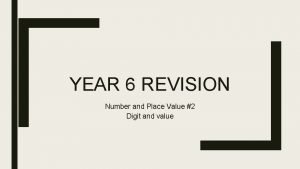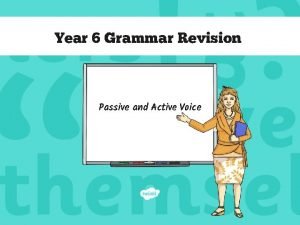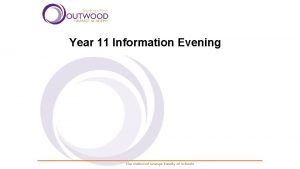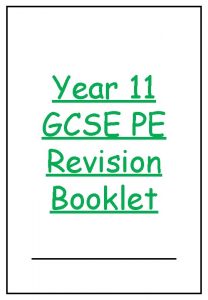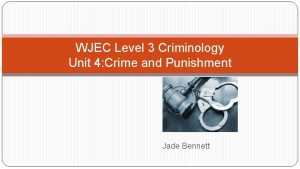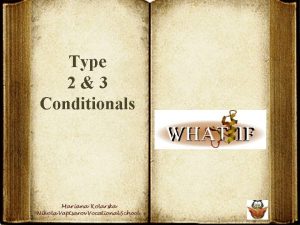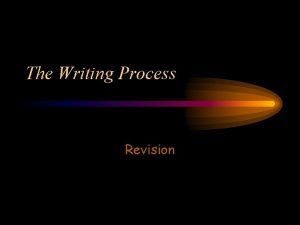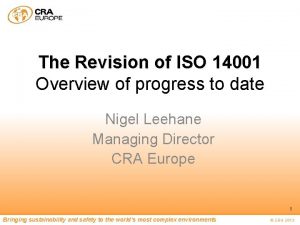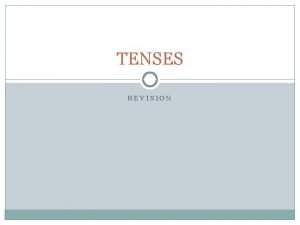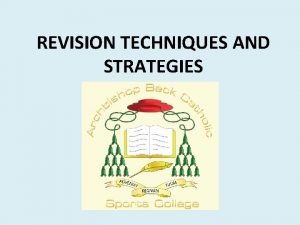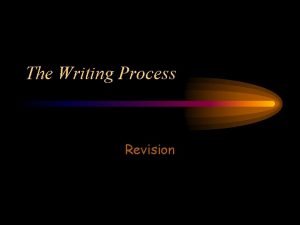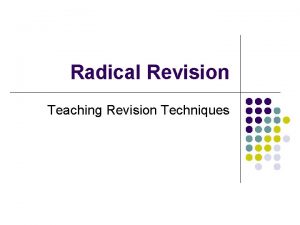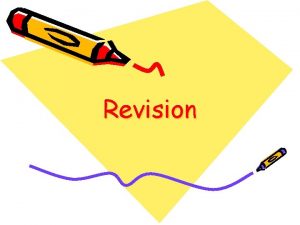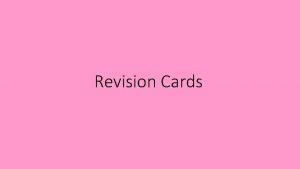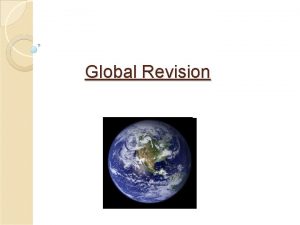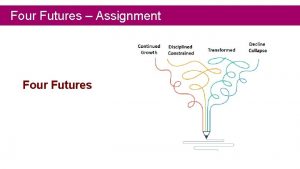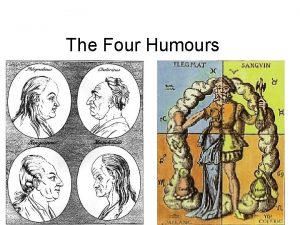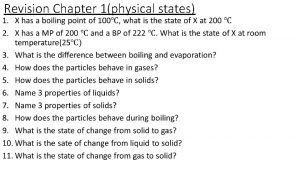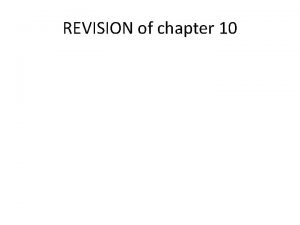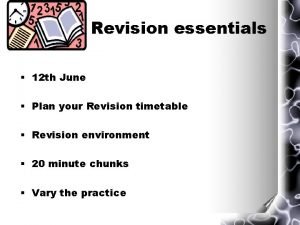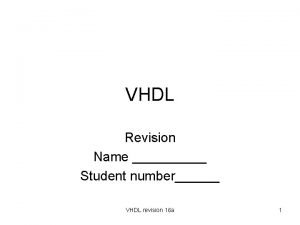Revision of Chapter Four Chapter Four a L


















- Slides: 18

Revision of Chapter Four

Chapter Four a) L mol-1 s-1 a) 6. 2 x 10 -3 atm/s b) L 2 mol-2 s-1 c) s-1 b) 1. 6 x 10 -3 atm/s d) s-2 c) 2. 5 x 10 -2 atm/s e) Mol L-1 s-1 d) -1. 6 x 10 -3 atm/s e) -2. 5 x 10 -2 atm/s

Chapter Four a) L mol-1 s-1 b) L 2 mol-2 s-1 a) 6. 2 x 10 -3 atm/s b) 1. 6 x 10 -3 atm/s d) s-2 c) 2. 5 x 10 -2 atm/s e) Mol L-1 s-1 d) -1. 6 x 10 -3 atm/s a) Δ(C)/Δt = Δ(A)/Δt b) Δ(C)/Δt = -(3/2) Δ(B)/Δt c) Δ(C)/Δt = -(2/3) Δ(B)/Δt d) Δ(C)/Δt = -(1/2) Δ(A)/Δt X 2 c) s-1 e) -2. 5 x 10 -2 atm/s

Chapter Four 1. The units for “rate reaction” are a) L mol-1 s-1 2. b) L 2 mol-2 s-1 c) s-1 d) s-2 e) Mol L-1 s-1 For the following reaction ΔP(C 6 H 14)/Δt was found to be -6. 2 x 10 -3 atm/s. C 6 H 14(g) → C 6 H 6(g) + 4 H 2(g) Determine ΔP(H 2)/Δt for this reaction at the same time? a) 6. 2 x 10 -3 atm/s 3. b) 1. 6 x 10 -3 atm/s c) 2. 5 x 10 -2 atm/s d) -1. 6 x 10 -3 atm/s e) -2. 5 x 10 -2 atm/s For the hypothetical reaction A+3 B→ 2 C, the rate of appearance of C given by (Δ(C)/Δt) may also be expressed as a) Δ(C)/Δt = Δ(A)/Δt b) Δ(C)/Δt = -(3/2) Δ(B)/Δt c) Δ(C)/Δt = -(2/3) Δ(B)/Δt d) Δ(C)/Δt = -(1/2) Δ(A)/Δt

Chapter Four a) The reaction is third order overall b) The reaction is second order overall c) The rate law is, rate = K [H 2 S]2 [O 2] d) The rate law is, rate = K [H 2 S] [O 2] e)The rate law can not be determine from the information given a) 2 b) 4 c) 6 d) 8 e) 9

Chapter Four 4. For the overall chemical reaction shown below, which one of the following statement can be rightly assume ? 2 H 2 S(g) + O 2(g) → 2 S(s) + 2 H 2 O(l) a) The reaction is third order overall b) The reaction is second order overall c) The rate law is, rate = K [H 2 S]2 [O 2] d) The rate law is, rate = K [H 2 S] [O 2] e)The rate law can not be determine from the information given 5. The reaction A+B → products has the rate law, rate = k [A] [B]3. If the concentration of B is doubled while that of A is unchanged, by what factor will the rate of the reaction increased? a) 2 6. b) 4 c) 6 d) 8 e) 9 Appropriate units for a first order rate constant are a) M/s b) 1/M. s c) 1/s d) 1/M 2. s

Chapter Four a) 13 min b) 86 min c) 137 min d) 222 min e) 284 min Now calculate t for 90% complete [A]0=100, [A]=100 -90=10, k= 8. 12 x 10 -3 min-1

Chapter Four 7. It takes 42 min for the concentration of a reactant in first order reaction to drop from 0. 45 M to 0. 32 M at 25°C. How long will it take for the reaction to be 90% complete ? a) 13 min 8. b) 86 min c) 137 min d) 222 min e) 284 min Nitric oxide gas (NO) react with chlorine gas according to the equation, NO + ½ Cl 2→NOCl, the following initial rate of reaction have been measured for the given regent concentrations. Exp. # Rate (M/hr) NO(M) Cl 2 (M) 1 1. 19 0. 50 2 4. 79 1. 00 0. 50 3 9. 59 1. 00 Which of the following is the rate law (rate equation) for this reaction ? a) Rate = k [NO] b) Rate = k [NO][Cl 2]1/2 c) Rate = k [NO][Cl 2] d) Rate = k [NO]2 [Cl 2] e) Rate = k [NO]2 [Cl 2]2 1. 00

Chapter Four 8. Nitric oxide gas (NO) react with chlorine gas according to the equation, NO + ½ Cl 2→NOCl, the following initial rate of reaction have been measured for the given regent concentrations. Exp. # Rate (M/hr) NO(M) Cl 2 (M) 1 1. 19 0. 50 2 4. 79 1. 00 0. 50 3 9. 59 1. 00 Which of the following is the rate law (rate equation) for this reaction ? a) Rate = k [NO] b) Rate = k [NO][Cl 2]1/2 c) Rate = k [NO][Cl 2] d) Rate = k [NO]2 [Cl 2] e) Rate = k [NO]2 [Cl 2]2 Rate = k [NO]2 [Cl 2] Rate = k [NO]x [Cl 2]y To find x To find y 1. 00

Chapter Four 7. It takes 42 min for the concentration of a reactant in first order reaction to drop from 0. 45 M to 0. 32 M at 25°C. How long will it take for the reaction to be 90% complete ? a) 13 min 8. b) 86 min c) 137 min d) 222 min e) 284 min Nitric oxide gas (NO) react with chlorine gas according to the equation, NO + ½ Cl 2→NOCl, the following initial rate of reaction have been measured for the given regent concentrations. Exp. # Rate (M/hr) NO(M) Cl 2 (M) 1 1. 19 0. 50 2 4. 79 1. 00 0. 50 3 9. 59 1. 00 Which of the following is the rate law (rate equation) for this reaction ? a) Rate = k [NO] b) Rate = k [NO][Cl 2]1/2 c) Rate = k [NO][Cl 2] d) Rate = k [NO]2 [Cl 2] e) Rate = k [NO]2 [Cl 2]2 1. 00

Chapter Four 9. The following initial rate data apply for the reaction F 2(g) + 2 Cl 2 O(g) → 2 FCl. O 2(g) + Cl 2(g) Exp. # Rate (M/s) F 2(M) Cl 2 O(M) 1 5 x 10 -4 0. 50 0. 01 2 2 x 10 -3 0. 50 0. 04 3 1 x 10 -3 1. 00 0. 01 Which of the following is the rate law (rate equation) for this reaction ? a) Rate = k [F 2]2 [Cl 2 O]4 b) Rate = k [F 2]2 [Cl 2 O] c) Rate = k [F 2] [Cl 2 O] d) Rate = k [F 2] [Cl 2 O]2 e) Rate = k [F 2]2 [Cl 2 O]2 Rate = k [F 2] [Cl 2 O] Rate = k [F 2]x [Cl 2 O]y To find x To find y

Chapter Four 9. The following initial rate data apply for the reaction F 2(g) + 2 Cl 2 O(g) → 2 FCl. O 2(g) + Cl 2(g) Exp. # Rate (M/s) F 2(M) Cl 2 O(M) 1 5 x 10 -4 0. 50 0. 01 2 2 x 10 -3 0. 50 0. 04 3 1 x 10 -3 1. 00 0. 01 Which of the following is the rate law (rate equation) for this reaction ? a) Rate = k [F 2]2 [Cl 2 O]4 b) Rate = k [F 2]2 [Cl 2 O] c) Rate = k [F 2] [Cl 2 O] d) Rate = k [F 2] [Cl 2 O]2 e) Rate = k [F 2]2 [Cl 2 O]2

Chapter Four 10. For the reaction X + Y Z, the reaction rate is found to depend only upon the concentration of X. A plot of 1/X verses time gives a straight line What is the rate law for this reaction? a) Rate = k [x] b) Rate = k [x]2 c) Rate = k [x] [y] d) Rate = k [x]2 [y]

Chapter Four 11. Which of the following statements is false? a) A catalyst increases the rate of the forward reaction, but does not alter the reverse rate. b) A catalyst alters the mechanism of reaction. c) A catalyst alters the activation energy. d) A catalyst may be altered in the reaction, but is always regenerated e) A catalyst increases the rate of reaction, but is not consumed. 12) Complete the following statement: A catalyst a) increases the activation energy. b) alters the reaction mechanism c) increases the average kinetic energy of the reactants. d) increases the concentration of reactants e) increases the collision frequency of reactant molecules.

Chapter Four 13. With respect to the figure below, which choice correctly identifies all the numbered positions? Activated complex products reactants 1 intermediate 2 3 4 a) Catalyst Intermediate Activated complex Products b) Reactants Activated complex Intermediate Products c) Reactants Activated complex Catalyst Products d) Reactants Intermediate Activated complex Products e) Reactants Intermediate Activated complex catalyst

Chapter Four 13. With respect to the figure below, which choice correctly identifies all the numbered positions? 1 2 3 4 a) Catalyst Intermediate Activated complex Products b) Reactants Activated complex Intermediate Products c) Reactants Activated complex Catalyst Products d) Reactants Intermediate Activated complex Products e) Reactants Intermediate Activated complex catalyst

Chapter Four a) 5 times b) 1. 16 times c) 15 times d) 2 times e) 0. 2 times

Chapter Four 14. The activation energy of a certain uncatalyzed reaction is 64 k. J/mol. In the presence of a catalyst, the Ea is 55 k. J/mol. How many times faster is the catalyzed than the uncatalyzed reaction at 400 C? Assume that the frequency factor remains the same? a) 5 times b) 1. 16 times c) 15 times d) 2 times e) 0. 2 times
 Passive revision
Passive revision Grundlagen englisch
Grundlagen englisch A shape with four straight sides
A shape with four straight sides 4 eyes skin assessment tool
4 eyes skin assessment tool Year 7 spanish revision booklet
Year 7 spanish revision booklet Place value of 865
Place value of 865 Look at the signs and rewrite them in the active
Look at the signs and rewrite them in the active Revision.english.outwood
Revision.english.outwood Gcse pe revision booklet
Gcse pe revision booklet Wjec criminology unit 4 advanced information
Wjec criminology unit 4 advanced information Wjec criminology unit 4
Wjec criminology unit 4 Unit 4 criminology
Unit 4 criminology Wjec hospitality and catering
Wjec hospitality and catering Virginia work area protection manual revision 2
Virginia work area protection manual revision 2 @ben1232323:the owner of a building
@ben1232323:the owner of a building What is revising?
What is revising? Iso 14001 revision
Iso 14001 revision Revision present simple tense
Revision present simple tense Crime and deviance sociology revision
Crime and deviance sociology revision





